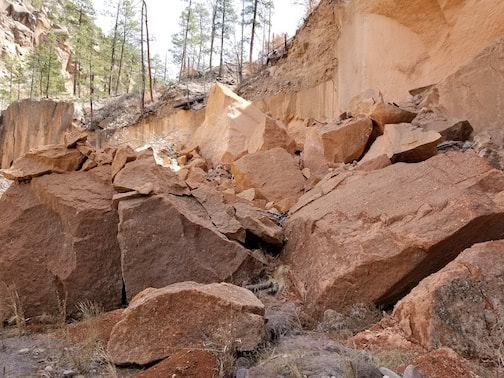The heart of Bandelier National Monument is Frijoles Canyon. This is the place of towering cliffs of warm volcanic tuff, the intriguing cliff dwellings of the Ancestral Puebloans, perched for centuries like swallows’ nests among the rocks, and fragrant Ponderosa pines whispering above a thread of water winding down from the mountains. It is a peaceful place.
But there is sudden violence concealed among the rocks. I made a hike yesterday along the middle reaches of Frijoles Creek, down from Upper Crossing to Alcove House, through the spectacular Narrows, upstream from more visited sites. The hammer blows of Nature were evident everywhere.
Nearly every tree in the canyon at Upper Crossing, from stream side to canyon rim, is dead, scorched in the holocaust of the Las Conchas Fire. The canyon floor is choked with boulder bars and snags of broken trees, piled high by flash floods. You can see an example in the photograph above.
But look up higher – and deeper. You can see an ancient canyon floor, cut into the orange volcanic tuff, and filled with the bouldery debris that marked its last flash flood. Above this are landslide deposits – perhaps the slide that pushed the creek into its present position, where it has resumed its canyon cutting.
And the sculpted walls of the Narrows seem eternal, but they are not. Part of the canyon is blocked by what must be a very recent rockfall:
But there is sudden violence concealed among the rocks. I made a hike yesterday along the middle reaches of Frijoles Creek, down from Upper Crossing to Alcove House, through the spectacular Narrows, upstream from more visited sites. The hammer blows of Nature were evident everywhere.
Nearly every tree in the canyon at Upper Crossing, from stream side to canyon rim, is dead, scorched in the holocaust of the Las Conchas Fire. The canyon floor is choked with boulder bars and snags of broken trees, piled high by flash floods. You can see an example in the photograph above.
But look up higher – and deeper. You can see an ancient canyon floor, cut into the orange volcanic tuff, and filled with the bouldery debris that marked its last flash flood. Above this are landslide deposits – perhaps the slide that pushed the creek into its present position, where it has resumed its canyon cutting.
And the sculpted walls of the Narrows seem eternal, but they are not. Part of the canyon is blocked by what must be a very recent rockfall:
This probably came down in one chisel stroke.
The geologist Derek Ager would call these observations small examples of “The Importance of the Rare Event in Geological History”. And so they are. Of course Bandelier conceals, in full view, evidence of a catastrophic event so large that it built the entire plateau from which the canyon is carved in a matter of hours to days: the emplacement of the upper Bandelier Tuff.
But that is another story.
If you are so minded, you might enjoy “The New Catastrophism” by Derek Ager.
The geologist Derek Ager would call these observations small examples of “The Importance of the Rare Event in Geological History”. And so they are. Of course Bandelier conceals, in full view, evidence of a catastrophic event so large that it built the entire plateau from which the canyon is carved in a matter of hours to days: the emplacement of the upper Bandelier Tuff.
But that is another story.
If you are so minded, you might enjoy “The New Catastrophism” by Derek Ager.



 RSS Feed
RSS Feed
